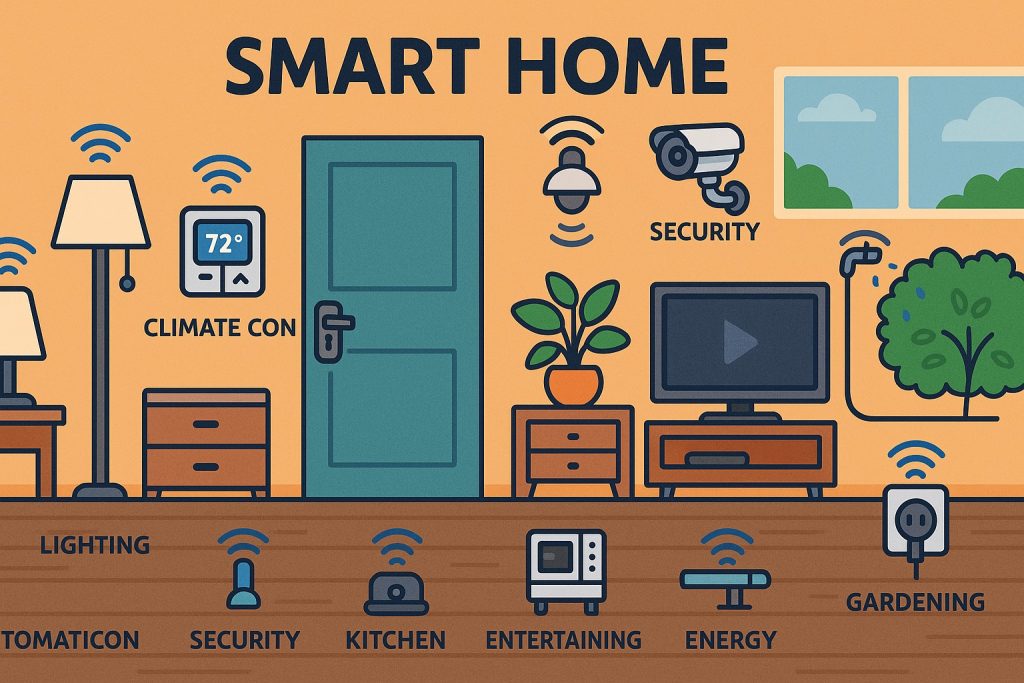Smart home technology is no longer a futuristic dream — it’s a practical reality available to millions of households worldwide. With rapid advancements in connectivity, sensors, and artificial intelligence, modern homes can automate everything from lighting and security to climate control and daily routines. This article explores what you can automate right now in a smart home and how it can improve comfort, efficiency, and safety.
What Is a Smart Home?
A smart home is a living space equipped with internet-connected devices that can be controlled remotely or programmed to operate automatically. These devices are often part of the Internet of Things (IoT) and can communicate with each other to create seamless home automation.
Key Areas You Can Automate Today
1. Lighting
- Motion-activated lights turn on when someone enters a room.
- Scheduled lighting can simulate presence while you’re away.
- Voice-controlled smart bulbs allow instant mood changes or energy-saving adjustments.
2. Climate Control
- Smart thermostats learn your preferences and adjust temperatures automatically.
- Some systems use geofencing to start heating or cooling as you approach home.
- Integration with weather forecasts helps optimize energy usage.
3. Security and Surveillance
- Smart locks can be opened remotely or with a fingerprint.
- Cameras and doorbells offer real-time video feeds and motion alerts.
- Systems can automatically lock doors, turn on lights, or sound alarms if unusual activity is detected.
4. Home Appliances
- Smart ovens, coffee makers, and washing machines can be started via apps.
- Robot vacuums clean on a schedule or when you leave the house.
- Smart fridges can monitor expiration dates and suggest shopping lists.
5. Entertainment Systems
- Automate TVs, speakers, and streaming services based on your routines.
- Set up movie night modes with preset lighting and audio settings.
- Control everything via smartphone or voice assistant.
6. Gardening and Irrigation
- Smart irrigation systems adjust watering based on soil moisture and weather.
- Some systems allow remote control or follow seasonal schedules automatically.
7. Energy Monitoring
- Smart plugs monitor and control energy consumption by device.
- Energy dashboards help identify power-hungry appliances.
- Some homes integrate solar panels with smart systems for optimal efficiency.
Benefits of Home Automation
- Convenience – manage your home from anywhere via phone or voice.
- Energy efficiency – reduce consumption and lower utility bills.
- Safety – protect against intrusions, fires, and leaks.
- Customization – tailor your environment to your lifestyle.
- Accessibility – essential support for the elderly or people with disabilities.
Getting Started: What You Need
To begin automating your home, you typically need:
- A smart hub or central controller (like Amazon Alexa, Google Home, or Apple HomeKit)
- A Wi-Fi network and mobile device
- Compatible smart devices (lights, locks, cameras, thermostats, etc.)
Most smart systems are modular — you can start with one area (like lighting) and expand gradually.
Conclusion
Smart home automation is already transforming how we live, offering real-time control, convenience, and improved quality of life. Whether you want to save energy, enhance security, or simply make daily tasks easier, smart devices are available right now to meet your needs. The future is not just coming — it’s already in your home.
Glossary
- Smart home – a residence equipped with internet-connected devices that automate tasks.
- Internet of Things (IoT) – a network of devices that collect and exchange data via the internet.
- Smart thermostat – a device that learns your heating/cooling preferences and adjusts automatically.
- Geofencing – technology that triggers actions based on your smartphone’s location.
- Smart plug – a plug that allows remote control and monitoring of electrical devices.


